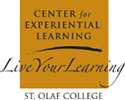You reached this page through the archive. Click here to return to the archive.
Note: This article is over a year old and information contained in it may no longer be accurate. Please use the contact information in the lower-left corner to verify any information in this article.
$250,000 grant confirms that location is key
November 23, 2011
 The importance of "location, location, location" is true even for academic real estate, as St. Olaf's Center for Experiential Learning (CEL) has learned.
The importance of "location, location, location" is true even for academic real estate, as St. Olaf's Center for Experiential Learning (CEL) has learned.
A $250,000 grant from the Arthur Vining Davis Foundations has resulted in a significant enhancement to the CEL, a key element of academic life at St. Olaf that plays an important role in the college's Main Street Initiative. The grant was used to relocate the CEL to Tomson Hall, the renovated science building that has become a central hub of campus activity since it opened last spring.
From January to May 2010 (pre-relocation), 1,097 students visited the CEL for advice on resumes and job interviews, and to investigate employment and internship opportunities. During that same period this year (post-relocation), 1,859 students visited the office for career assistance — a 69 percent increase in traffic that translates into "students, students, students."
"Students walk by our offices on their way to classes, meals, and activities," says Steven McKelvey, interim director of the CEL. "Through our transparent walls they see their friends and peers working closely with CEL staff. Our new space is public and inviting — qualities that draw students on their first steps to taking advantage of our services."
Academic impact
 CEL programs and services benefit students on campus and off. The Civic Engagement program, for example, promotes classroom-based activities that contribute to the needs of the Northfield community while challenging students to be responsible citizens. In 2010–11, 28 courses promoted such civic engagement components as Chinese language students setting up an after-school club for high school students studying Chinese; students developing educational materials related to healthy eating at an elementary school; and social work students meeting with elderly retirees to record their stories.
CEL programs and services benefit students on campus and off. The Civic Engagement program, for example, promotes classroom-based activities that contribute to the needs of the Northfield community while challenging students to be responsible citizens. In 2010–11, 28 courses promoted such civic engagement components as Chinese language students setting up an after-school club for high school students studying Chinese; students developing educational materials related to healthy eating at an elementary school; and social work students meeting with elderly retirees to record their stories.
In addition, academic internships enable students to build on coursework as they tackle real-world challenges under the supervision of both an employer and a faculty mentor. During the 2009–10 academic year and summer, St. Olaf students completed 176 academic internships for credit, 37 of which happened abroad.
The Main Street Initiative takes its name from the "main street" that runs along Tomson's east-west axis. That corridor — with the Admissions Office on the west end and the CEL on the east, and resources such as the Office of International and Off-Campus Studies in between (along with the Education and language departments, plus various administrative offices) — aims to connect the first and last days of a student at St. Olaf through a sequence of curricular and co-curricular programs that teach students how to shape and implement a vocation and career plan that aligns with their talents and interests.
Read more stories about the CEL: "Taking class research into the community," "Creating more leaders for social change," "Students 'psyched' for community action," "Two sisters, two companies, one realization," and "The power of connections."
